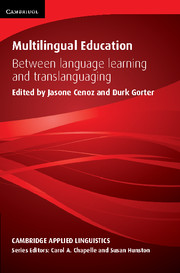Book contents
- Frontmatter
- Contents
- List of contributors
- Series editors’ preface
- Acknowledgements
- 1 Towards a holistic approach in the study of multilingual education
- 2 L1 as a pedagogical resource in building students’ L2 academic literacy: pedagogical innovation in the science classroom in a Hong Kong school
- 3 Linking content, linking students: a cross-linguistic pedagogical intervention
- 4 The role of the native language in the literacy development of Latino students in the United States
- 5 A nexus analysis of code choice during study abroad, and implications for language pedagogy
- 6 Multilingual practices in foreign language study
- 7 Language choices and ideologies in the bilingual classroom
- 8 Communicative repertoires in the community language classroom: resources for negotiating authenticity
- 9 Complementary classrooms for multilingual minority ethnic children as a translanguaging space
- 10 Constructing in-between spaces to ‘do’ bilingualism: a tale of two high schools in one city
- 11 Becoming multilingual and being multilingual: some thoughts
- Index
9 - Complementary classrooms for multilingual minority ethnic children as a translanguaging space
Published online by Cambridge University Press: 17 September 2021
- Frontmatter
- Contents
- List of contributors
- Series editors’ preface
- Acknowledgements
- 1 Towards a holistic approach in the study of multilingual education
- 2 L1 as a pedagogical resource in building students’ L2 academic literacy: pedagogical innovation in the science classroom in a Hong Kong school
- 3 Linking content, linking students: a cross-linguistic pedagogical intervention
- 4 The role of the native language in the literacy development of Latino students in the United States
- 5 A nexus analysis of code choice during study abroad, and implications for language pedagogy
- 6 Multilingual practices in foreign language study
- 7 Language choices and ideologies in the bilingual classroom
- 8 Communicative repertoires in the community language classroom: resources for negotiating authenticity
- 9 Complementary classrooms for multilingual minority ethnic children as a translanguaging space
- 10 Constructing in-between spaces to ‘do’ bilingualism: a tale of two high schools in one city
- 11 Becoming multilingual and being multilingual: some thoughts
- Index
Summary
Introduction
The term ‘translanguaging’ has recently been taken up by many researchers of multilingualism as an encompassing term for a variety of multilingual practices, traditionally termed as code-switching, code-mixing, borrowing and crossing, which are commonplace amongst multilingual language users. It has served as a corrective of the still widespread perception that such practices are somehow out of the ordinary, abnormal or deviant, by highlighting the positive and creative dimensions of the practices (see a review in García & Li Wei, 2014 ). In this chapter, I will examine the translanguaging practices of children of immigrant background in a specific socio-educational context as evidence of their creativity, criticality and multicompetence. The group of children I am focusing on in this chapter are those of Chinese ethnic origin in Britain. They are best described as transnationals: most of them are British-born, but many are of immigrant background, that is, their parents were born outside Britain; some of them have lived in other parts of the world. The specific context that I am studying is that of complementary schools, a voluntary education provision made available by minority ethnic, usually immigrant, communities in Britain to support their children's learning and use of the ethnic languages. Through a detailed analysis of classroom exchanges amongst the pupils and their teachers, I want to argue that translanguaging has a transformative capacity, as it creates a social space for the multilingual language user by bringing together different dimensions of their personal history, experience and environment, their attitude, belief and ideology, their cognitive and physical capacity into one coordinated and meaningful performance, thereby making it into a lived experience. I have called this space ‘translanguaging space’, a space for the act of translanguaging as well as a space created through translanguaging (Li Wei, 2011 ). As we will see through the examples of the pupils’, and their teachers’, alternation between languages and between modes of communication (e.g. speaking and writing), the complementary schools for minority ethnic children in Britain provide just such a translanguaging space. Skills, knowledge and identities are acquired and developed through the act of translanguaging.
- Type
- Chapter
- Information
- Multilingual EducationBetween Language Learning and Translanguaging, pp. 177 - 198Publisher: Cambridge University PressPrint publication year: 2015
- 8
- Cited by

